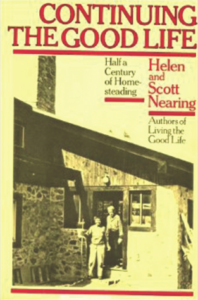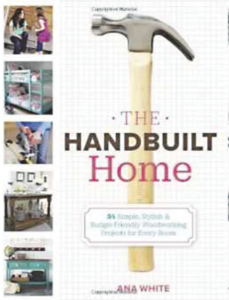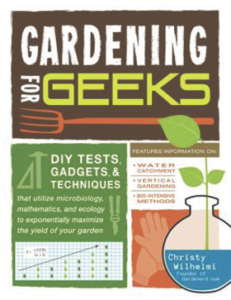Living the Good Life and Continuing the Good Life; The Handbuilt Home; Gardening for Geeks
—by Adele Flail
In case you missed them the first time
Living the Good Life: How to Live Sanely and Simply in a Troubled World (1954)
Continuing the Good Life: Half a Century of Homesteading (1979)
by Helen and Scott Nearing
Fed up with the crowded, materialistic pace of city life and equally eager to escape the frustrations of ongoing economic woes, an enterprising couple leaves New York City for a homestead in the Vermont mountains—experimenting with a life of self-sufficiency while writing it all down: It sounds like the gist of a zeitgeisty blog from 2013, but this tale belongs to Helen and Scott Nearing, who started their exploration of homesteading during the Great Depression. The Nearings’ life work was creating a life of work: a life filled with “real, vital, urgent, important” activity—subsistence farming, music, writing and conversation. These  two books chronicle how the Nearings moved to the country and grew cash crops—producing maple syrup at their first “Forest Farm” in Vermont, then blueberries at their second homestead in Maine—to raise just the money they needed for items they couldn’t grow themselves, while pursuing other interests.
two books chronicle how the Nearings moved to the country and grew cash crops—producing maple syrup at their first “Forest Farm” in Vermont, then blueberries at their second homestead in Maine—to raise just the money they needed for items they couldn’t grow themselves, while pursuing other interests.
These books are rich with details that will fascinate anyone who’s dreamed of dismantling their wheel in the rat race: If you’d like to learn how to build your own sizeable stone house or enrich your understanding of how to garden during the winter, you’ll find the wisdom of the Nearings’ 50-year experiment. And experiment it was, in the nature of Thoreau’s explorations: The Nearings also share their thoughts on the social aspects of their farming experience—from opening their home to visitors (a practice which eventually caused the couple to flee their once-haven in Vermont after it became surrounded by a ski resort, and well-meaning but constant drop-ins) to forming cooperative alliances with neighbors who, even in rural areas, were already making the transition to the individualistic, cash-based, mechanized life we all lead now. You’ll find fascinating biography, detailed explanations for how to make a life off the beaten path work (or for things to stay away from: one chapter is titled “Remodeling Old Wooden Buildings: Don’t!”), and lots of inspiration to chase down your own Walden or Forest Farm.
Potpourri
The Handbuilt Home: 34 Simple, Stylish & Budget-Friendly Woodworking Projects for Every Room (2012) by Ana White. Potter Craft Press
A whole summer spent exploring high-Uintas meadows or excavating out in the garden can leave your indoor spaces looking a little… neglected (that’s the word for disgorged daypacks and dirty towels everywhere, right?). If you’re looking for a way to spruce up your home and keep occupied during the chilly days  ahead, grab your hammer but first check out The Handbuilt Home by Ana White. Filled with plans for a variety of furniture projects, you’ll find pretty embellishments for your space—such as an upholstered headboard or media console—as well as ways to enjoy the fruits of your summer adventures—from cute photo frames (I know you’ve Instagrammed more than one mountain sunrise this year) to a farmhouse table, perfect for setting out a harvest feast. The furniture styles in the book are simple (a cross between “grandma’s farmhouse” and “Ikea modern”) but the clear, unintimidating diagrams and pictures provide a perfect base for experimenting with customization. Be warned (or rejoice!): This is a pretty girly book, and probably won’t appeal to your gruff Uncle Milt…
ahead, grab your hammer but first check out The Handbuilt Home by Ana White. Filled with plans for a variety of furniture projects, you’ll find pretty embellishments for your space—such as an upholstered headboard or media console—as well as ways to enjoy the fruits of your summer adventures—from cute photo frames (I know you’ve Instagrammed more than one mountain sunrise this year) to a farmhouse table, perfect for setting out a harvest feast. The furniture styles in the book are simple (a cross between “grandma’s farmhouse” and “Ikea modern”) but the clear, unintimidating diagrams and pictures provide a perfect base for experimenting with customization. Be warned (or rejoice!): This is a pretty girly book, and probably won’t appeal to your gruff Uncle Milt…
or to heavily experienced woodworkers. But it will provide many useful projects for the beginner-to-intermediate power-tool wielder (always wear safety glasses, and take off your rings!)
Gardening For Geeks: DIY Tests, Gadgets, & Techniques That Utilize Microbiology, Mathematics, and Ecology to Exponentially Maximize the Yield of Your Garden (2013), Christy Wilhelmi (Adams Media)
This book might disappoint botany majors, with nary a Punnett square or scanning electron microscope image in sight. However, if this dampens your enthusiasm, you should know that this is one of the most solid gardening reference books of the past year, packing in a ton of gardening info that touches on virtually every aspect of gardening that the urban farmer would need to know.  Covering garden design and planning through harvest and storage—with a few tasty recipes (crispy kale chips, anyone?) thrown in for good measure— would-be garden geeks will be delighted to find detailed information about the ins and outs of topics like soil testing, how to build raised beds, how to pinch tomato suckers to tame indeterminates, and a history of fertilizers—as well as some fun science facts (Did you know that lightning strikes fix massive amounts of nitrogen into the soil each year?)
Covering garden design and planning through harvest and storage—with a few tasty recipes (crispy kale chips, anyone?) thrown in for good measure— would-be garden geeks will be delighted to find detailed information about the ins and outs of topics like soil testing, how to build raised beds, how to pinch tomato suckers to tame indeterminates, and a history of fertilizers—as well as some fun science facts (Did you know that lightning strikes fix massive amounts of nitrogen into the soil each year?)
Look for tips for creating a worm bin and the secret for storing seeds over multiple years, as well as a detailed dossier of all of the most popular veggies and greens.
Wilhelmi also covers the basics of bionynamics and French Intensive to help you eke the most out of your space—
a skill which you can see in action in this little book, which is densely packed with tips, tricks and detailed explanations of how things work in your little ecosystem. You can also check out Wilhelmi’s blog (http://www.gardennerd.com) for more info.
